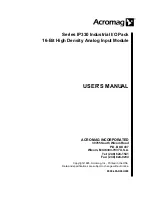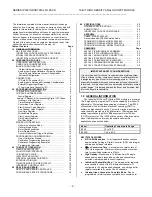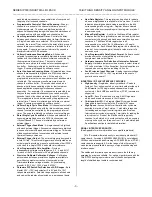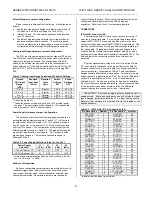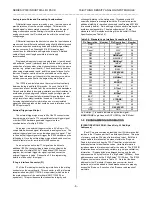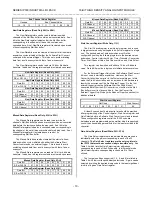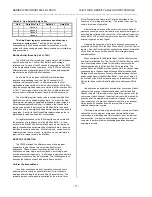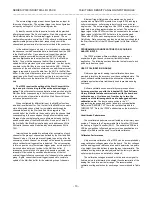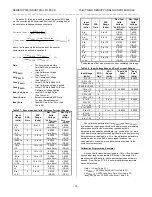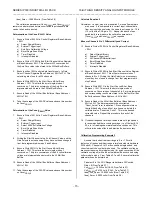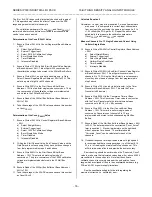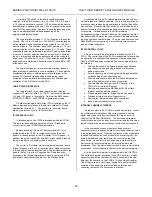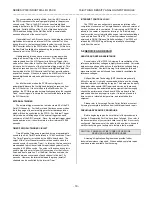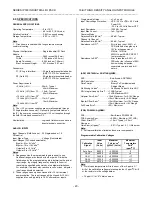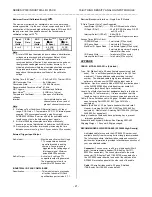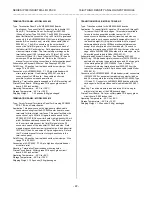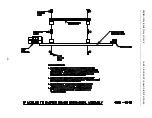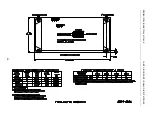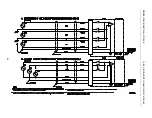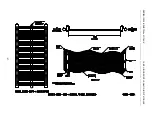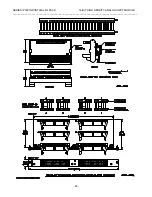
SERIES IP330 INDUSTRIAL I/O PACK 16-BIT HIGH DENSITY ANALOG INPUT MODULE
___________________________________________________________________________________________
- 15 -
Ideal_Zero = -10.0000 volts (From Table 3.8)
The calibration parameters (CountCALHI and CountCALLO)
remain to be determined before uncorrected input channel data
can be taken and corrected.
Determination of the CountCALLO Value
1.
Execute Write of 043AH to Control Register at Base Address
+ 00H.
a) Select Straight Binary
b) External Trigger Input
c)
Auto Zero Calibration Voltage
d) Burst Single Scan Mode
e) Timer
Disabled
f) Interrupts
Disabled
2.
Execute Write of 1F00H to End/Start Channel Value Register
at Base A 06H. This will permit 32 conversions of
the Auto Zero value to be stored in the 32 Mail Box Buffers.
3.
Execute write of 00H, as byte data transfers only, to Gain
Select Channel Registers Base A 20H to 3FH. This
selects a gain of one for all 32 channels.
4.
Execute Write 0001H to the Start Convert Bit at Base
A 10H. This starts the burst single mode of
conversions. Thirty two conversions of the Auto Zero are
implemented and stored in the 32 Mail Box Buffers.
5.
Execute Read of the 32 Mail Box Buffers at Base A
40H to 7EH.
6.
Take the average of the 32 ADC values and save this number
as CountCALLO.
Determination of the CountCALHI Value
7.
Execute Write of 041AH to Control Register at Base Address
+ 00H.
a) Select Straight Binary
b) External Trigger Input
c)
Select 4.9000v Calibration Voltage
d) Burst Single Scan Mode
e) Timer
Disabled
f) Interrupts
Disabled
8.
Writing the Start Channel Value, End Channel Value, and the
Gain Selects is not necessary if they have not been changed
from that programmed in steps 2 and 3 above.
9.
Execute Write 0001H to the Start Convert Bit at Base
A 10H. This starts the burst single mode of
conversions. Thirty two conversions of the 4.9 volt calibration
voltage are implemented and stored in the 32 Mail Box
Buffers.
10. Execute Read of the 32 Mail Box Buffers at Base A
40H to 7EH.
11. Take the average of the 32 ADC values and save this number
as CountCALHI.
Calculate Equation 2
Calculate m = actual_slope from equation 2, since all parameters
are known. It is now possible to correct input channel data
from any input channel using the same input range (i.e. -10 to
+10 volts with a PGA gain = 1). Repeat the above steps
periodically to re-measure the calibration parameters
(CountCALHI and CountCALLO) as required.
Measure Channels 0 to 3 Differentially and Correct
12. Execute Write of 0402H to Control Register at Base Address
+ 00H.
a) Select Straight Binary
b) External Trigger Input
c)
All Channels Differential Input
d) Burst Single Scan Mode
e) Timer
Disabled
f) Interrupts
Disabled
13. Execute Write of 0300H to End/Start Channel Value Register
at Base A 06H. This will permit conversions of
channels 0 to 3. Writing the Gain Selects is not necessary
since they do not need to change from that programmed in
step 3 above.
14. Execute Write 0001H to the Start Convert Bit at Base
A 10H. This starts the burst single mode of
conversions. Conversions of channels 0 to 3 are implemented
and corresponding results are stored in the first four Mail Box
Buffer locations at Base A 40H to 46H.
15. Execute Read of the 4 Mail Box Buffers at Base A
40H to 46H. The data represents the uncorrected
“Count_Actual” term in equation 1. Since all parameters on
the right hand side of equation 1 are known, calculate the
calibrated value "Corrected_Count". This is the desired,
corrected value. Repeat this procedure for each of the
channels.
16. If channel response time requirements are not high speed it
is recommended that a running average (i.e. of the last 8, 16,
32, etc.) of readings be maintained for each channel. This
will minimize noise effects and provide the best accuracy.
Calibration Programming Example 2
Assume that the desired input range is 0 to +1.25 volts
(selection of the desired input range is implemented via hardware
DIP switch). Channels 3 to 13 are connected single ended, and
corrected input channel data is desired. The calibration voltages
are converted using burst single mode (for quick conversion of the
calibration voltages) while the actual data will be converted using
uniform single mode. From Tables 3.7 and 3.8, several calibration
parameters can be determined:
Preselect 0 to 10v ADC Range via hardware DIP switch.
Gain = 8 (From Table 3.7)
VoltCALHI = 1.2250 volts (CAL2; From Table 3.7)
VoltCALLO = 0.6125 volts (CAL3; From Table 3.7)
Ideal_Volt_Span = 10.0000 volts (From Table 3.8)
Ideal_Zero = 0.0000 volts (From Table 3.8)

